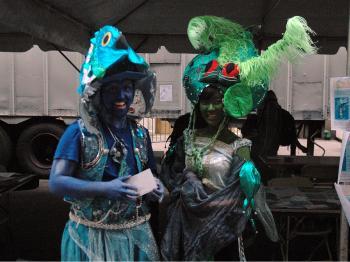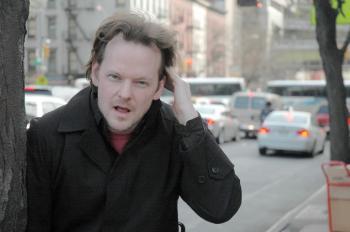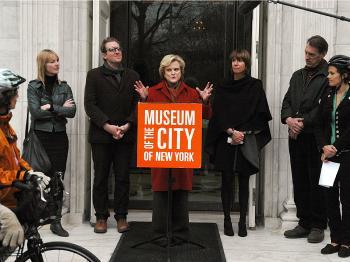NEW YORK—Despite waning attendance, the Metropolitan Repertory Ballet Company still strives to exhibit innovation while preserving the traditional side of ballet dancing.
“Ballet is the lowest attended stage art right now, but we can’t blame the loss of attendance on the Internet and television,” said Leonora Volpe, president of the Metropolitan Repertory Ballet. “In the ‘50s, people were glued to the screen but ballet was at a high point; people were scalping tickets for a thousand dollars.
“Over the years, there has been a major disconnect between the producers and the audience,” said Ms. Volpe, who believes that changes can be made to classical ballets but they must not detract from the author’s intent or change the original idea in any negative way. “They take something that is tried and true and they change it. You get directors that come in and want to re-invent the wheel,” she said.
Ballet groups perform classic ballets with little change to the original dance, create completely new ballets, or take a traditional ballet set in a different time frame. According to Volpe, “Faust” set in the bayous of 1800s Louisiana was amazing. “Cinderella” set in the ‘20s was horrible. Instead of the wonderful Baroque ball gowns and the loose flowing shirts the men would wear, they had tail coats and big medals and the women had flapper-type dresses on.
As a dance lover, I can verify what Volpe is saying. When I saw an excerpt from “La Traviatta” Grand Salon style, it was in such an intimate setting that I could see the dancers’ effort to execute the precise steps and movements. The performers not only danced with purity, but, more than that, they acted out each character’s story. They conveyed a character’s emotion—the pain, the joy, and the rage, evident through the dancer’s movements and facial expressions—to the audience a few feet away. This is what ballet is all about, not just the technical aspect of it. The passion the performers feel for the story they are telling translates into either a heartfelt performance or a bland one.
“The ballets are about people, and what is lost in strictly following only technique is the human emotion that made it so popular in the past,” Volpe said.
Art proliferated in New York City in the 1920s and ‘30s, which led to many small ballet groups being established. This, in turn, led to the opening of many new venues and created competition among the groups. As a consequence, the ballet groups exhibited much ingenuity as each established its unique voice in order to draw an audience. There was no room to abase the art, which Volpe feels is happening today.
Now groups have to rent their venues and funding is difficult to find. In addition, many venues have closed since the early 1970s. New York boasts only a few ballet groups now, and one of them is usually touring in Europe where the market is better.
The Metropolitan Repertory Ballet has 10 full-time dancers, but has hired as many as 80 depending on funding and need. Volpe finds extra dancers through word-of-mouth and auditions. She is known to pay well but has high standards for those hired.
Ms. Volpe knew how hard it was to be a young dancer and not get paid well, so she wanted to make sure dancers were paid what she thought they were worth even if she didn’t get paid that well, Jonathan Kness, tenor and musical director for the Metropolitan Repertory Ballet explained.
The Metropolitan Repetory Ballet may be one of the few safe havens for working, serious ballet dancers in New York.
“Ballet is the lowest attended stage art right now, but we can’t blame the loss of attendance on the Internet and television,” said Leonora Volpe, president of the Metropolitan Repertory Ballet. “In the ‘50s, people were glued to the screen but ballet was at a high point; people were scalping tickets for a thousand dollars.
“Over the years, there has been a major disconnect between the producers and the audience,” said Ms. Volpe, who believes that changes can be made to classical ballets but they must not detract from the author’s intent or change the original idea in any negative way. “They take something that is tried and true and they change it. You get directors that come in and want to re-invent the wheel,” she said.
Ballet groups perform classic ballets with little change to the original dance, create completely new ballets, or take a traditional ballet set in a different time frame. According to Volpe, “Faust” set in the bayous of 1800s Louisiana was amazing. “Cinderella” set in the ‘20s was horrible. Instead of the wonderful Baroque ball gowns and the loose flowing shirts the men would wear, they had tail coats and big medals and the women had flapper-type dresses on.
As a dance lover, I can verify what Volpe is saying. When I saw an excerpt from “La Traviatta” Grand Salon style, it was in such an intimate setting that I could see the dancers’ effort to execute the precise steps and movements. The performers not only danced with purity, but, more than that, they acted out each character’s story. They conveyed a character’s emotion—the pain, the joy, and the rage, evident through the dancer’s movements and facial expressions—to the audience a few feet away. This is what ballet is all about, not just the technical aspect of it. The passion the performers feel for the story they are telling translates into either a heartfelt performance or a bland one.
“The ballets are about people, and what is lost in strictly following only technique is the human emotion that made it so popular in the past,” Volpe said.
Art proliferated in New York City in the 1920s and ‘30s, which led to many small ballet groups being established. This, in turn, led to the opening of many new venues and created competition among the groups. As a consequence, the ballet groups exhibited much ingenuity as each established its unique voice in order to draw an audience. There was no room to abase the art, which Volpe feels is happening today.
Now groups have to rent their venues and funding is difficult to find. In addition, many venues have closed since the early 1970s. New York boasts only a few ballet groups now, and one of them is usually touring in Europe where the market is better.
The Metropolitan Repertory Ballet has 10 full-time dancers, but has hired as many as 80 depending on funding and need. Volpe finds extra dancers through word-of-mouth and auditions. She is known to pay well but has high standards for those hired.
Ms. Volpe knew how hard it was to be a young dancer and not get paid well, so she wanted to make sure dancers were paid what she thought they were worth even if she didn’t get paid that well, Jonathan Kness, tenor and musical director for the Metropolitan Repertory Ballet explained.
The Metropolitan Repetory Ballet may be one of the few safe havens for working, serious ballet dancers in New York.



